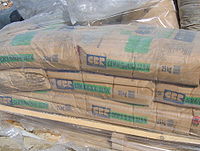
Photo from wikipedia
Abstract The tightening of environmental standards in the EU including the presupposed abatement of coal combustion power plants presents an important impulse towards the transition to a circular economy. However,… Click to show full abstract
Abstract The tightening of environmental standards in the EU including the presupposed abatement of coal combustion power plants presents an important impulse towards the transition to a circular economy. However, the achievement of this challenging goal requires a solution to a number of problems. One of the downstream problems consists in the fact that the application of fly ash originating in coal combustion (CFA) as a partial cement replacement might be gradually abandoned in future decades. The first reason may be economical as the increasing environmental regulations will probably result in its more costly processing. The second one is related to the increasing use of alternative energy sources which can lead to the decreasing availability of CFA. Biomass fly ash (BFA) originating from wood combustion can be considered as one of the prospective environmentally more friendly candidates for a partial replacement of CFA as supplementary cementitious material (SCM). In this paper, functional aspects of a possible replacement of CFA by BFA in blended cements are analyzed. Complex characterization of BFA performed prior to the other investigations reveals very good prerequisites for its use as SCM. The experimental analysis of functional properties of Portland cement-BFA based composites after 28-days curing shows the suitability of BFA as SCM for the cement replacement up to 30% by mass. The data collected after 90 and 180 days of curing indicate a substantial improvement of strength of all analyzed composites. The significantly lower content of hazardous elements in BFA in a comparison with CFA presents another benefit; it can be used in blended cements without any further processing or treatment.
Journal Title: Construction and Building Materials
Year Published: 2020
Link to full text (if available)
Share on Social Media: Sign Up to like & get
recommendations!